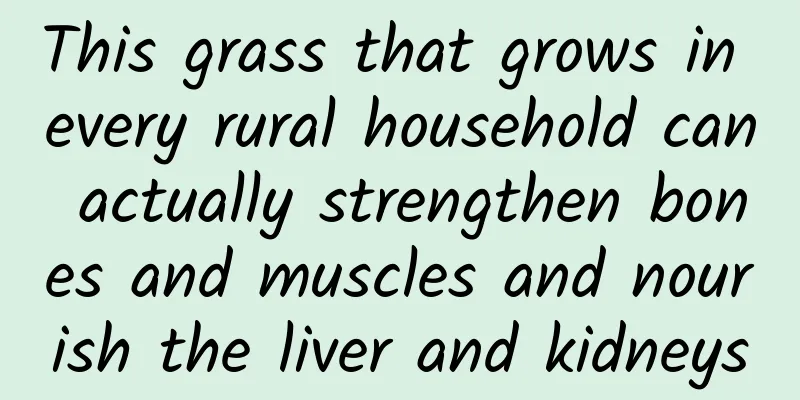Green "King of Health" specializes in curing "immortal cancer"

|
Chicory is a special plant that has both edible and medicinal functions. It has been listed as a "medicinal and edible" food by the Ministry of Health and is praised as the green "king of health" by experts from the National Nutrition Alliance. Studies have shown that the effective components of chicory can significantly reduce the increase of uric acid and blood sugar caused by hyperglycemia, and comprehensively regulate the interactive disorder of lipids, sugars and uric acid. Chicory extract can significantly improve hyperuricemia and abdominal obesity caused by a high-purine diet, thereby playing a comprehensive role in regulating uric acid and abdominal fat accumulation. For easy consumption, chicory has been made into a tea substitute and entered our lives. An unknown wild grass turns out to be the nemesis of the "immortal cancer" gout! Indications Clears away heat and detoxifies; promotes diuresis and reduces swelling. It is mainly used to treat jaundice due to damp-heat; edema caused by nephritis; abdominal distension and pain; and loss of appetite. It also has stomachic effects. Why can such an inconspicuous grass cure our immortal cancer - gout? So let us first understand what gout is. Gout is a crystal-related arthritis caused by the deposition of monosodium urate (MSU), which is directly related to hyperuricemia caused by purine metabolism disorders and/or decreased uric acid excretion. It specifically refers to acute characteristic arthritis and chronic tophi disease, mainly including acute onset arthritis, tophi formation, tophi-induced chronic arthritis, urate nephropathy and uric acid urinary stones. In severe cases, joint disability and renal insufficiency may occur. Gout is often accompanied by abdominal obesity, hyperlipidemia, hypertension, type 2 diabetes and cardiovascular disease. The typical site for subcutaneous tophi to occur is the auricle, but it is also common around joints with recurrent attacks and in areas such as the olecranon, Achilles tendon, and patellar bursa. The appearance is yellow-white growths of varying sizes raised under the skin. The skin surface is thin, and white powdery or pasty substances are discharged after rupture, which does not heal for a long time. Clinical manifestations Gout is more common in middle-aged men, while women account for only 5%, mainly postmenopausal women. Gout tends to occur in younger people. The natural course of gout can be divided into four stages: asymptomatic hyperuricemia stage, acute stage, intermittent stage, and chronic stage[3]. Clinical manifestations are as follows: 1. Acute gouty arthritis Most patients have no obvious signs before an attack, or only experience fatigue, general malaise, and joint pain. A typical attack often begins with awakening the patient in the middle of the night due to joint pain. The pain progressively intensifies, reaching a peak in about 12 hours, and feels like tearing, cutting, or biting, which is unbearable. The affected joints and surrounding tissues are red, swollen, hot, painful, and have limited function. Usually resolves spontaneously within a few days or 2 weeks. The first attack often affects a single joint, some of which occur at the first metatarsophalangeal joint. Later in the course of the disease, some patients also have involvement of this area. The next most common joints are the dorsum of the foot, heel, ankle, knee, wrist and elbow. The shoulder, hip, spine and temporomandibular joints are less frequently affected. Multiple joints may be affected at the same time, manifesting as polyarthritis. Some patients may have systemic symptoms such as fever, chills, headache, palpitations and nausea, which may be accompanied by increased white blood cell count, increased erythrocyte sedimentation rate and increased C-reactive protein. 2. Intermittent attack period Gout attacks can last for several days to several weeks and then resolve on their own, usually with no obvious sequelae, or leaving local skin pigmentation, desquamation, and itching. They then enter an asymptomatic interval period and relapse after several months, years, or more than ten years. Most patients relapse within one year, and the episodes become more and more frequent, affecting more and more joints, and the symptoms lasting longer and longer. The affected joints generally develop from the lower limbs to the upper limbs, from the distal small joints to the large joints, and the joints such as the fingers, wrists and elbows are affected. A small number of patients may be affected in the shoulder, hip, sacroiliac, sternoclavicular or spinal joints, and may also affect the bursae, tendons and tendon sheaths around the joints. The symptoms tend to be atypical. A small number of patients have no intermittent period and present with chronic arthritis symptoms after the initial onset. 3. Chronic tophi stage Subcutaneous tophi and chronic tophi-induced arthritis are the result of long-term significant hyperuricemia, with large amounts of monosodium urate crystals deposited in the subcutaneous tissue, synovium, cartilage, bone, and periarticular soft tissue. The typical site for subcutaneous tophi to occur is the auricle, but it is also common around joints with recurrent attacks and in areas such as the olecranon, Achilles tendon, and patellar bursa. The appearance is yellow-white growths of varying sizes raised under the skin. The skin surface is thin, and white powdery or pasty substances are discharged after rupture, which does not heal for a long time. Subcutaneous tophi often coexist with chronic tophi arthritis. Large amounts of tophi deposited in joints can cause joint bone destruction, periarticular tissue fibrosis, and secondary degenerative changes. Clinical manifestations include persistent joint swelling, pain, tenderness, deformity and dysfunction. Symptoms in the chronic phase are relatively mild, but acute attacks may also occur. 4. Kidney disease (1) Chronic urate nephropathy Urate crystals are deposited in the renal interstitium, leading to chronic tubulointerstitial nephritis. The clinical manifestations include decreased urine concentrating function, increased nocturia, low specific gravity urine, small molecule proteinuria, leukocyturia, mild hematuria and tubular urine. In the late stage, it can lead to decreased glomerular filtration function and renal insufficiency. (2) Uric acid urinary stones: The uric acid concentration in the urine increases to a supersaturated state, depositing in the urinary system and forming stones. The incidence rate in gout patients is over 20% and may occur before gouty arthritis occurs. Small stones are excreted in the urine in the form of gravel and may be asymptomatic; larger stones may block the urinary tract and cause renal colic, hematuria, dysuria, urinary tract infection, renal pelvic dilatation and hydrops, etc. (3) Acute uric acid nephropathy: The uric acid levels in the blood and urine increase sharply, and a large amount of uric acid crystals are deposited in the renal tubules, collecting ducts, etc., causing acute urinary tract obstruction. Clinical manifestations include oliguria, anuria, and acute renal failure; a large number of uric acid crystals can be seen in the urine. It is mostly caused by secondary causes such as malignant tumors and their radiotherapy and chemotherapy (i.e. tumor lysis syndrome). |
>>: Even if you have the "immortality drug", you still have to know how to use it
Recommend
What are the effects and functions of raw charcoal?
Raw earth charcoal has many functions and effects...
The role and efficacy of Forsythia
In our medicine, Forsythia suspensa has very good...
The efficacy and function of chicken bone grass
Many people don’t know much about chicken bone gr...
The efficacy and function of Mopan grass
Do you know what millstone grass is? If you know,...
The efficacy and function of ground lotus
Do you know what the ground lotus is? It is a kin...
Four major complications of long-term bed rest
Long-term bed rest is very harmful to people. It ...
Best way to apply Plumbago leaves externally
Pleurotus ostreatus is a very powerful Chinese me...
The efficacy and function of blood wind vine
Although Western medicine and Western drugs are m...
What changes will the body go through after pregnancy? Today, let's say "thank you" to our mothers
The annual Mother's Day is here In this warm ...
Can ginseng be stored in the refrigerator?
In the past, ginseng was a tonic that many people...
Why do octopuses spray (throw) things at each other?
Octopuses in Australia throw gravel at each other...
The efficacy and function of the heartwood of lacquer tree
The heart of Lacquer Tree is a very good medicina...
Happy Labor Day! Remember the "five ones" for health, and don't stop being healthy during the holidays!
Take some time off during the May Day holiday, bu...
The efficacy and function of fishing rod firewood
Traditional Chinese medicine is very effective in...
Why is it so bitter when you take a bite of cucumber? That's the cucumber crying for help!
Some cucumbers are very sweet when you take a bit...









